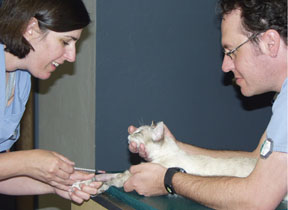As far as you can tell, your six-year-old cat, Lucretia, has never had a sick day in her life. If she has, shes certainly never shown any signs of it. Nevertheless, youve dutifully made a point of taking her to her veterinarian for a routine physical exam twice a year, just to make sure shes up-to-date on her vaccinations and is not harboring any obscure and subtle systemic anomaly that could eventually prove troublesome.

288
Youre doing the right thing, says William Miller, VMD, medical director at Cornell Universitys Companion Animal Hospital, and all cat owners would do well to follow suit. “Its a very good idea to have every cat undergo a twice-yearly exam,” he says. “This is especially true for geriatric cats – those that are age 10 and older – and for animals that spend time outdoors and are exposed to a host of feline diseases.” A thorough checkup should also be obligatory, he advises, for any new cat that is brought into a household and for kittens when they reach one year of age.
Owners should know what is involved in a routine examination. They should also know that a standard exam, which could cost in the neighborhood of $100, is, in Dr. Millers words, “a very cost-effective step in preventive medicine.”
The routine physical exam will typically include four elements: a medical history of the patient, a physical examination, a complete blood count and a blood serum chemistry panel. In addition, many veterinarians will also do a urinalysis in the routine exam, especially for a geriatric patient.
Medical History
“Well want to know what kind of food the cat is eating,” says Dr. Miller, “and if there have been any changes in its litter-box activity. Is it urinating or defecating more often or less often? Is there any change in the texture or color of its feces? Have there been any dramatic changes in its general behavior? The answers to these types of questions can tell you a lot about a cats general health.”
Therefore, says Dr. Miller, owners – in anticipation of a routine checkup and the questions that a veterinarian might ask – should regularly monitor their cats activities so that they can serve as accurate “historians.”
Physical Exam
After listening to the chest with a stethoscope, the veterinarian will manually palpate the cats entire torso and its limbs, feeling by hand for signs of internal disease. “Primarily,” says Dr. Miller, “well be looking for any masses in the abdomen or intestines, any swollen lymph glands, any abnormalities in the limbs or joints, or any other suspicious lumps or bumps.”
Complete Blood Count
Using about one-twentieth of an ounce of an animals blood, the CBC includes the following major measurements and evaluations:
A packed cell volume (hematocrit) reveals the concentration of red blood cells in the plasma. A low red-cell concentration might indicate that an animal is anemic – either because its bone marrow isnt producing the cells in sufficient number or because they are being lost or destroyed. A high red-cell concentration could mean that the cat is dehydrated.
A red blood cell count measures the actual number of red cells in a given amount of blood and discerns any abnormalities in their shape, size or color. The amount of hemoglobin – a substance that transports oxygen throughout the bloodstream – is also assessed.
A white blood cell count evaluates and counts the number of leukocytes (including lymphocytes, neutrophils, monocytes, eosinophils and basophils), all of which are produced in the bone marrow or other tissues and play various roles in attacking and destroying disease-causing organisms. A high white-cell count might indicate, for example, that an animal is harboring an infection, is under extraordinary stress or is affected by a serious and chronic illness, such as leukemia.
A platelet count measures the concentration of disk-shaped blood cells (thrombocytes) that promote vitally necessary blood-clotting.
The CBC also measures the protein levels in blood plasma. Low levels of these proteins suggest, for example, the possibility of liver, kidney or gastrointestinal malfunction, while high levels indicate the presence of infection, chronic inflammation or some types of cancer.
Chemistry Panel
In these tests, the quantity of a dozen or more substances is evaluated in order to assess a wide range of health-determining factors. The chemistry panel can reveal problems in an animals organ function. It can measure the levels of necessary hormones. And it can determine whether the blood is sufficiently rich in electrolytes – chemical compounds that regulate the exchange of necessary electrical charges across cell membranes.
Abnormal (or subnormal) blood levels of various substances may indicate damage or disease involving the kidneys, liver, muscles or glands. For example:
High levels of alkaline phosphatase may indicate liver damage, while excess blood urea nitrogen (BUN) and creatinine suggest possible kidney dysfunction.
Elevated amounts of amylase may indicate kidney or pancreatic disease.
Abnormal calcium levels may indicate the presence of tumors, kidney disease or other disorders.
High levels of blood sugar (glucose) may indicate diabetes.
Low levels of potassium may explain an animals chronic lethargy or lack of muscle strength.
In addition, a chemistry panel measures total protein, including one called albumin and others known as globulins. High or low blood levels of these proteins can influence many bodily processes, including the ability to retain water and to defend against infection.
Urinalysis
A urinalysis is often carried out for cats with urinary abnormalities, such as increased urine production or urination frequency, difficulty in urination or abnormal urine color. The test is also useful in confirming that a cat appearing to be in perfect health is indeed free of any subtle, underlying physical disorders, such as diabetes.
A Speedy Process
“But assuming that the patient is cooperative, you can do an entire exam, start to finish, in 15 minutes.”


